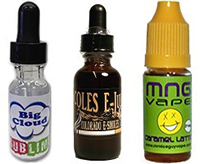
Electronic cigarettes – commonly known as e-cigs – have been gaining steady popularity in the United States since they were introduced in 2007, four years after its invention in China. You’ve probably seen or heard about them but did you know that another market has grown in conjunction with e-cigs? Unlike traditional cigarettes that use tobacco, e-cigs use a solution called e-liquid (or e-juice and vape juice), and when heated by the e-cig, it emits a vapor instead of smoke. In this article, we will examine some noteworthy trends happening with e-liquid labels so product owners and consumers can better understand this emerging market.
E-Liquid Labels – A Growing Niche
Over the last couple years, the demand for custom e-liquid labels has been growing stronger as more e-liquid manufacturers are entering the market due to e-cigarettes’ increasingly popular. As a result, the need to differentiate and appeal to consumers has created some label trends unique to the market. Whether you’re an e-liquid manufacturer who is starting out or expanding your labeling strategy, these trends can be helpful for planning your next label order.
Digital Printing
- Digital printing is a great fit with the e-liquid label market because it’s a cost-effective method for printing small batches of high quality labels with multiple designs – ideal for product owners with various e-liquid flavors. Digital printing’s variable data label printing techniques can also come in handy if serialized barcodes or consecutive numbering is needed for keeping track of products.
Eye-Catching Designs
- Thanks to the flexibility of digital printing, we’ve seen e-liquid labels have all sorts of designs. E-liquid labels can be printed on many different materials; however, there are several types that are more popular than others, such as: semi-gloss, clear and foil label materials. Semi-gloss is a great option for product owners looking for durable, glossy labels at an affordable cost. Metallic and clear label materials are also frequently used in the e-liquid label market because they can elevate the e-liquid’s packaging and attract consumers by making the e-liquid flavor more enticing.
Small Label Size
- Somewhat straightforward, but none the less important, another trend we’ve found is that most e-liquid labels are small (e.g. 1.25” x 2.5”). It makes sense considering that e-liquids are typically packaged in small quantities ranging from 10 – 35 ml. The label size is an important consideration for e-liquid label buyers because it influences how much space is allowed for design, as well as, the cost per label.
FDA and Labeling Requirements
It’s important to note that there are currently no labeling regulations for e-cig products – as of yet. The Federal Drug Administration (FDA) and other health organizations have raised concerns that there hasn’t been enough research on the effects of e-cigs, and that it may attract adolescents since it’s considered by most users to be a healthier alternative to tobacco cigarettes. Although there are no labeling regulations, e-liquid product owners should still exercise caution by properly labeling their product.
Final Thoughts for E-Liquid Label Buyers
Manufacturers can be proactive about possible regulation issues by examining their labeling strategy. One way manufacturers can better ensure public health safety is to have product information easy to find with clear, legible labels that display the e-liquid’s ingredients, warnings, and directions. We’ve built our internal systems with various quality controls so our customers’ e-liquid labels always have crisp graphics and text.


